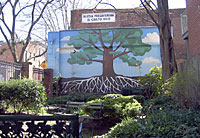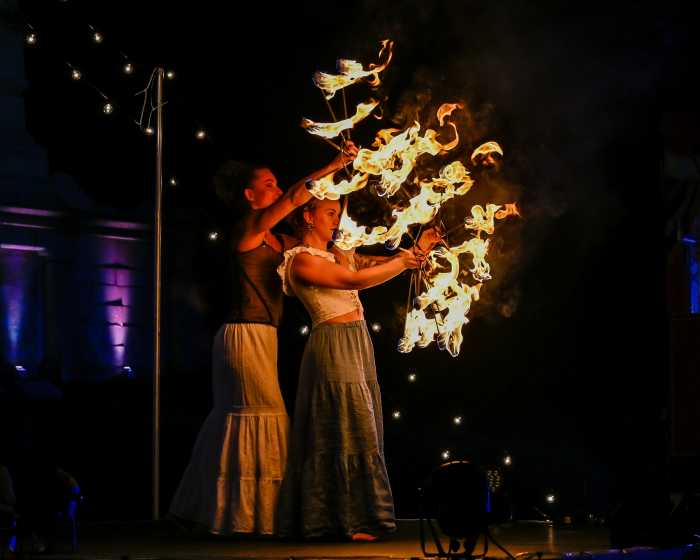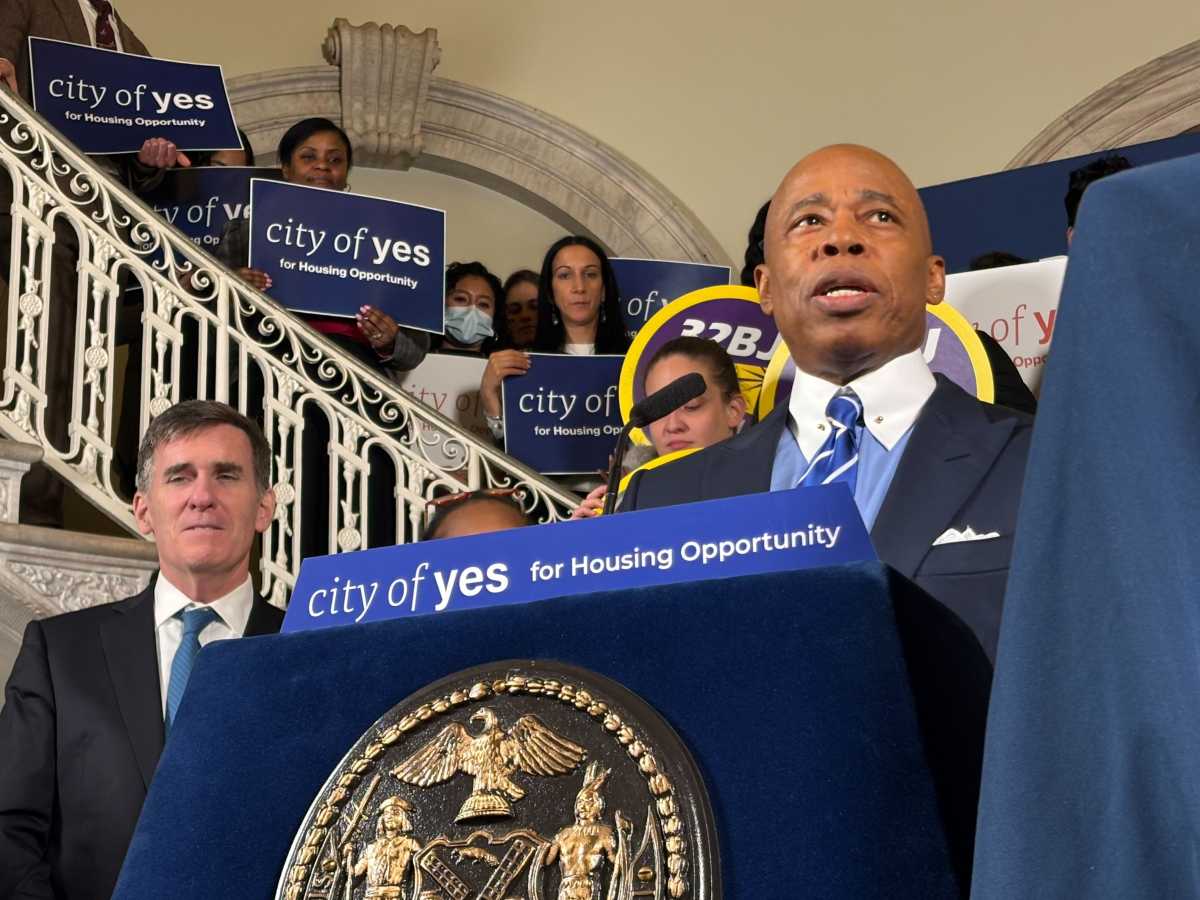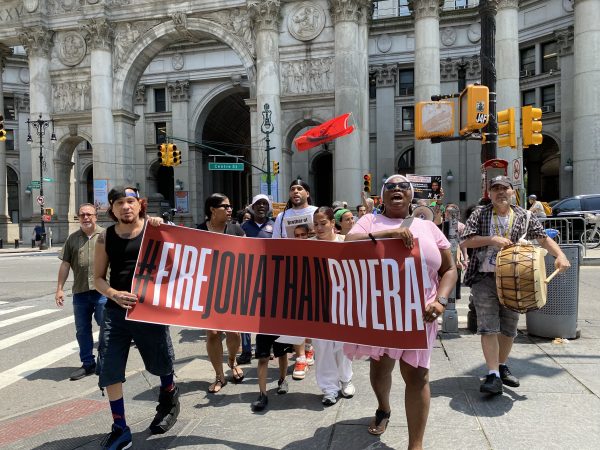A Boerum Hill community garden that survived for decades on little more
than silver bells and cockleshells is now in the crosshairs of a battle
between the neighbors who planted it and the church that owns it.
With spring summoning daffodils, bluebells and goldenrod to poke through
the Hoyt Street Garden’s wrought-iron fence and buds to sprout on
its knobby oak tree, the Iglesia Del Vivo Cristo, or Church of the Living
Christ, has asked the Hoyt Street Association, which built and planted
the garden, to get lost.
Margaret Cusack, founder of the Hoyt Street Association, who lives only
doors from the little pink church on Hoyt Street between Atlantic Avenue
and Pacific Street that abuts the garden, says she’s not moving any
time soon and hopes the garden that she and others helped to plant doesn’t
have to, either.
“People talk about this as an oasis,” said Cusack, who described
the past three decades of interactions with the church “fairly congenial.”
“They never got involved with any of the work, any of the planting
or any decision-making about the park,” she said. “They had
sort of a hands-off relationship.”
So when the Hoyt Street Association received a letter from the church
saying it would “retake the complete and incompatible use” of
the garden for sale and future development, Cusack was shocked.
The letter, signed by Rosa Nieves, the church secretary on behalf of “The
Elders of the Church ‘Del Vivo Cristo’” had the name of
the pastor, the Rev. Alfredo A. Ferraras-Perez at the top, and was mysteriously
dated Jan. 19, 2005.
“As you know, very soon it will be 30 years since we generously permitted
you to use our property gratuitously,” Nieves wrote. “We acknowledge
that you’ve made a very positive development in the creation of the
garden for the community, however presently this church has the urgent
necessity to revise and re-launch its evangelical mission.
“In so doing, we are reorganizing and re-evaluating our resources
to this end. It is with our deep feeling of respect that we are giving
you written notices of our unalterable decision to acquire the total undivided
use of the considered property.”
It was the first Cusack had heard of the church’s desire to be rid
of he garden.
“When I called them I said, ‘This is very startling news,’”
she recalled.
Over the years, Cusack said, she remembered members of the church occasionally
enjoying the garden, and even holding a wedding there one afternoon.
“We give away keys to anybody who’s interested,” she said,
noting that all the local schools had keys, along with the public library
branch and all interested church members. “The rules are here —
Pick up litter, and don’t pick the flowers.”
The once gravel-strewn empty lot was sold to the church in 1970, and had
been vacant for five years until the community started the garden.
“They said they were indeed ready to sell the land and if we wanted
to buy it we could certainly be on the list,” she said, and hoped
something could be done to raise enough money for the corner lot.
She hopes, instead, to work something out with the church, and exchange
community labor and rent payments to subsidize the “park in perpetuity.”
Telephone conversations between Cusack and the New York Presbytery —
which owns the land — were only mildly reassuring, she said.
“They said they wanted ‘nothing other than a courtyard garden’
there,” said Cusack, who said she was told that all sale decisions
have to go through the church’s Grand Assembly, which would take
time.
Cusack said she understood an apartment building with a rectory for the
pastor was being considered.
Ferraras-Perez deferred comment until after press time.
The New York Presbytery did not return calls for comment by press time.
Sue Wolfe, president of the Boerum Hill Association, and a broker at Nancy
McKiernan Realtors on Atlantic Avenue, just down the street from the garden,
said her neighborhood organization was concerned, and it would affect
the accolades the block has received for winning “Greenest Block
in Brooklyn” awards.
“For 30 years they’ve let the neighborhood use it, so the neighborhood
loves the fact that it’s been there,” she said. “It’s
a wonderful neighborhood institution. Do we have a right to it? No. But
maybe we can raise enough money that we can buy it. Who knows?
“My daughter was read to there, and now she reads there,” Wolfe
said, and fondly recalled summer afternoons in the garden with her children
at the Hoyt Street Garden summer reading program, for which the Hoyt Street
Association provides snacks, books and an amplifier so the readings can
be heard over the din of Atlantic Avenue traffic.
Assemblywoman Joan Millman, who represents Boerum Hill, called the readings
just “one example of the various ways this small plot of land has
been utilized to create a strong sense of neighborhood” in a support
letter she wrote to the association, one of many received by the group
including letters from the non-profit Project for Public Spaces, the Gowanus
Community Center, State Street Cathedral Block Association, local real
estate broker Carol May, neighborhood shops, residents, neighborhood expatriates
and even students from nearby PS 261.
Student Elly Figueroa wrote, “PS 261 is really concerned … We
will do anything to help you find another place for you to build the building
you want to build. Living things should live.”
Miles, also from PS 261, threatened protest, writing, “I will not
let you tear down the Hoyt Street Garden … Plants give us oxygen
and in the city there is too much car filth in the air. So keep the garden.”
But whether the church will listen remains to be seen, and the letter
from Ferraras-Perez conveyed a steely determination.
“The decision to retake the complete and incompatible use of the
referred property is just legitimate, necessary and cannot wait any longer,”
the letter reads. “We ask for your understanding and comprehension.”























